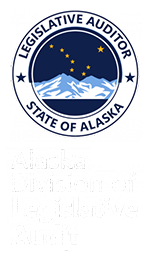| SUMMARY OF: | A Performance Audit of the Department of Public Safety, Alaska Scientific Crime Detection Laboratory , Select Issues |
Why DLA Performed This Audit
The audit of the Crime Lab was requested, in part, to determine if the new crime lab facility had an impact on available forensic services and the extent services were outsourced. The audit evaluates whether evidence control procedures at the new facility are suitably designed to ensure the integrity of evidence, identifies the number of untested Sexual Assault Response Team kits stored at the Crime Lab, and documents backlogs for all services. The audit determines staff turnover and evaluates personnel practices. Lastly, the audit evaluates and verifies the accuracy of the Crime Lab’s performance measures.
Report Conclusions
The audit concludes that the new Crime Lab facility has not expanded the forensic services provided or reduced the process time for service requests. Despite the completion of the new Crime Lab facility, no additional forensic services have been added.
Toxicology related to traffic offenses is the only forensic service consistently outsourced. The cost of outsourcing traffic-related offenses is partially covered by a federal grant.
The audit was unable to evaluate the costs versus benefits of expanding the Crime Lab to provide additional forensic services due to a lack of cost data. A survey of law enforcement agencies identified a demand for additional forensic services, especially toxicology.
The audit found that from July 2007 through April 2016, backlogs existed in most services; however, backlogs have been reduced in 2016. According to a survey of Crime Lab forensic scientists and technicians, the primary reason for backlogs has been a lack of forensic scientists. The audit identified that 20 forensic scientist and technician positions were vacant in excess of six months during the audit period.
There were 122 Sexual Assault Response Team (SART) kits stored at the Crime Lab as of July 20, 2016. Of the 68 SART kits awaiting analysis by the Crime Lab, 74 percent were in backlog status (older than 30 days). The total number of untested kits maintained by law enforcement agencies statewide is unknown, as Crime Lab management lacks a method for tracking the number of kits distributed or used.
The audit concludes that Crime Lab evidence control procedures do not adequately protect against evidence theft or loss. Furthermore, improvements are needed in building security and access controls to adequately protect sensitive areas of the Crime Lab.
A comparison to national benchmarks was not possible; however, the audit provides processing information to help gauge productivity between fiscal years. Fifty-five percent of the forensic analysis service requests received between July 2015 and
April 2016 were completed within 30 days.
The audit concludes that performance measures were not accurately reported by Crime Lab management. Additionally, turnaround time from the date evidence was received by the Crime Lab to the date results were provided to the requesting agency was not tracked or reported. The audit also found unreliable information was used to calculate performance measures related to the DNA database.
The Crime Lab experienced consistent staff turnover from
July 2007 through April 2016. The turnover rate does not appear excessive except for the FY 10 rate showing that 44 percent of physical discipline forensic staff left the lab. Review of personnel practices found improvements were needed over staff supervision and hiring.
Findings and Recommendations
1. DPS’ commissioner should ensure building security and evidence control procedures minimize the potential for evidence loss and theft.
2. The Crime Lab manager should develop policies and procedures to ensure access to the Laboratory Information Management System (LIMS) is granted based on users’ business needs.
3. The Crime Lab manager should develop and follow detailed written procedures to ensure all employees complete security clearance verification prior to accessing LIMS.
4. The Crime Lab manager should comply with policies and procedures over drug standards.
5. DPS’ commissioner should develop policies and procedures to ensure performance measures are accurate, relevant, complete, and based on an appropriate methodology.

